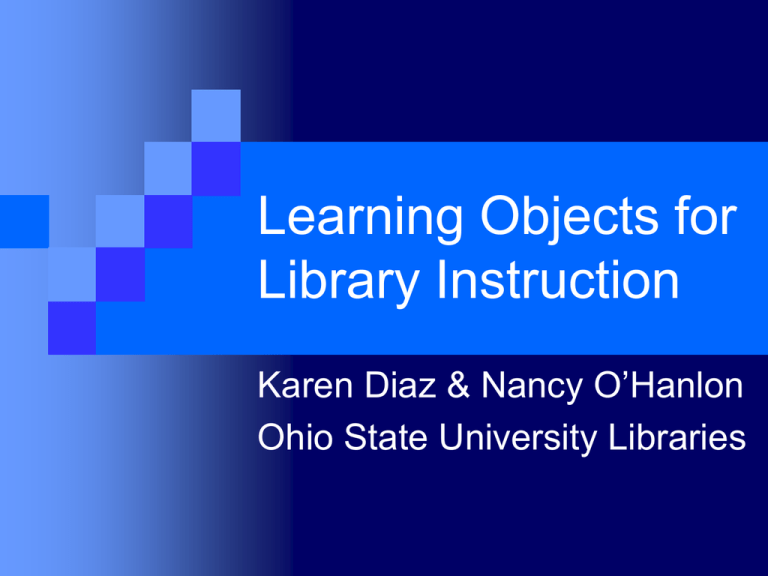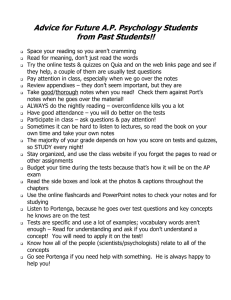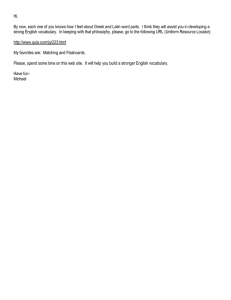Learning Objects for Library Instruction Karen Diaz & Nancy O’Hanlon
advertisement

Learning Objects for Library Instruction Karen Diaz & Nancy O’Hanlon Ohio State University Libraries Part 1: Theory and Resources Karen Diaz What is a Learning Object? Simple definition: Any digital resource that can be reused to support learning --David Wiley Context for Discussing LOs Distance Education Online Resources Digital Environment Examples of (pieces of) Learning Objects Simulations Electronic calculators Animations Tutorials Text entries Web sites Bibliographies Audio and video clips Quizzes Photographs Illustrations Diagrams Graphs Maps Charts Assessments WISC Online definition New way of thinking about learning content (2-15 minutes) Small independent chunks of knowledge Clear instructional strategy Self-contained Interactive Reusable Able to be aggregated Tagged with metadata Learning that is: - Just enough - Just in time - Just for you Splitting Hairs Digital Assets Learning Objects Real Examples of LOs CNN/Money Interactions with Customers Searching 101: Identify Concepts How to Find Learning Objects Google? Lists? Repositories! Features of LO Repositories Database searching Keyword Browsing (taxonomy or whole database) Features cont’d Metadata Technical (format, size,location, duration) Educational (age/grade levels, pedagogic features, language, context) Rights (conditions of use, cost, copyright restrictions) Relationships to other LOs (identifier numbers, catalog entry number) Classification (taxonomy, keywords) Features cont’d Access to Object/Preview User communities Best practices Commenting/evaluation of LOs by users Features cont’d Tracking For rights management Information for the creator Who has used Why? Context? Examples of Repositories MERLOT Gateway to Education Materials WISC-Online Maricopa Learning Exchange CORIL – Cooperative Online Repository for Information Literacy Others Part 2: Building Learning Objects Nancy O’Hanlon Goals for this portion of workshop Identify software programs that can be used to create learning objects. Show examples of some learning objects created with various tools. Discuss guidelines for digital content development. Review Universal Design issues to keep in mind as you build or select learning objects. 3 Dimensional LOs Material – text, images, charts, etc. to convey new information Activity – simulations, games, guided tasks to reinforce learning Assessment – quiz, portfolio, product to determine success Making Digital Learning Materials Web page editor to write HTML text Style sheet component or program for format Javascript for interactive components Image development software Functions may be combined in one application (Dreamweaver Studio MX) or separate programs (Frontpage and Photoshop) Example: Finding Articles Creating Interesting Activities Watching/listening Simulations Doing Interactive games Guided tasks Quizzes and self-tests Simulations Definition: Representation of the operation or features of one process or system through the use of another In library instruction context, very useful for teaching about search tools, processes Screen Capture Software for Simulations Camtasia Studio HyperCam RoboDemo ViewletBuilder (also ViewletCam) How They Work Capture screen shots and mouse/cursor movements as you perform a process Review, add or delete slides Annotate, highlight elements on slides Some programs support interactive elements Output files that you upload to Web server Example: ViewletBuilder Example: What's A Viewlet? Example: Basic search in Google Interactive Games Types of interactions Flashcards Matching Others (crosswords, etc) Possible instructional uses Enhance recall (e.g.vocabulary development) Bloom’s Knowledge, Comprehension levels Game Development - Quia Create using templates, choose output May re-use existing objects Free for users; subscription for instructors Examples: Quia Web Game Development - Hot Potatoes Create using templates Free for most educational use Examples: Crossword puzzle Matching Guided Tasks - Action Mazes Definition: a kind of interactive case-study; the user is presented with a situation, and a number of choices as to a course of action to deal with it. Useful for procedural training, problem-solving exercises Bloom’s Application, Analysis levels as well as Synthesis (predicting outcomes) Software tool: Quandary Example:Apollo 10 Guided Tasks - WebQuests Definition: an inquiry-oriented activity in which most or all of the information used by learners is drawn from the Web. Learner given a task, set of information sources, guidance on how to organize information found. Supports thinking at Bloom’s levels of Analysis, Synthesis and Evaluation. Example: Walker's Watermelon WebQuest Finally, Assessment Most commonly quizzes, tests Construct within course management software (WebCT, Blackboard) Construct with Respondus Build stand-alone quizzes using Quia or Hot Potatoes Hot Potatoes Quiz Instant feedback Score not recorded Example: Web Site Purpose Quia Quiz / Class Quia can create several kinds of quizzes: Instant feedback, score not retained Instant feedback, score retained in class gradebook Example Quia Class Page Performance-Based Assessment Develop student instructions Create grading rubric Share these with others as part of the total LO package Resource: Field-Tested Learning Assessment Guide Overview of LO Development Develop learning objectives Outline a sequence for instruction Plan delivery of segments/chunks. Build a flowchart of content with specific objectives, examples. Select software tools Create material and activities Design an appropriate assessment Usable / Reusable Content Inverted pyramid style of writing for the Web – important ideas first, then expand. Be succinct: KYSS Students scan, not read – help them out with highlighting, mnemonics. What is the reading level of your text? MS Word can tell you. Engage multiple senses – linguistic and perceptual information processed in different ways. Address Student Learning Styles Almost half may be visually-oriented learners Need to present learning material in formats that address different/multiple learning style preferences Mix of text, illustrations, charts and graphic organizers – something for everyone! Universal Design for Learning (UDL) Goal: create a learning environment that meets ALL of the diverse needs of the students in a class. Instead of remediating students so that they can learn from a set curriculum, curriculum should be made flexible to accommodate learner differences -- different backgrounds, learning styles, abilities, and disabilities. UDL Theory Brain research reveals that there are various networks involved in learning: Recognition – what we learn – provide multiple examples, formats, media Strategic – how we learn – provide models, practice with support, ongoing feedback Affective – why we learn – offer choice of content, tools, levels of challenge UDL Online Book Teaching Every Student in the Digital Age Part 3: Evaluation Karen Diaz Evaluating LO’s Why? How? Why Evaluate To decide if existing LO matches your desired outcomes To make you better at creating your own LO’s How to Evaluate – NLII Observation Tool Granularity Feedback Interaction (technology) Manipulation (content) Learning Design Adaptation Assessment (content) Interaction (technology) Feedback (content) Let’s Try an Evaluation --Take out your observation tool The Supreme Court Justices Report back on activities Learning Object evaluations Repository evaluations Creation tools evaluations How Can We Use Learning Objects? “ Faculty need learning objects to create courses. Most faculty members develop their own courses to guide student learning of specific concepts and their relationships among them. Faculty teaching distance education courses need to be able to access instructional materials that teach the specific concepts they have set as objectives for their course.” --From Learning About Learning Objects Rethinking Library Instruction Instead of … We can now … One shots Provide little shots…over and over as needed Teaching broad concepts Teach specific chunks as they are relevant to the instructor or student Labor geared at reaching EVERY student once Labor in deeper and more timely learning opportunities for students Being content-centric (concern for “covering the material”) Focus on being learner-centric (interesting things to do rather than dumping loads of data) Not knowing if our efforts are doing any good Build various forms of assessment into the activities Being bound by lectures and workshops Have new ways to think about providing learning content

